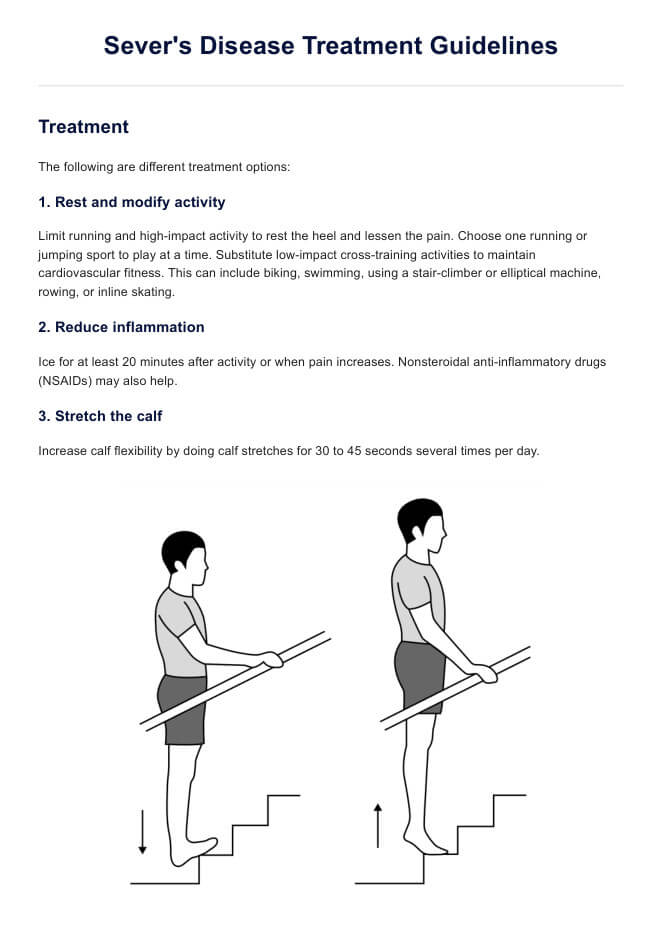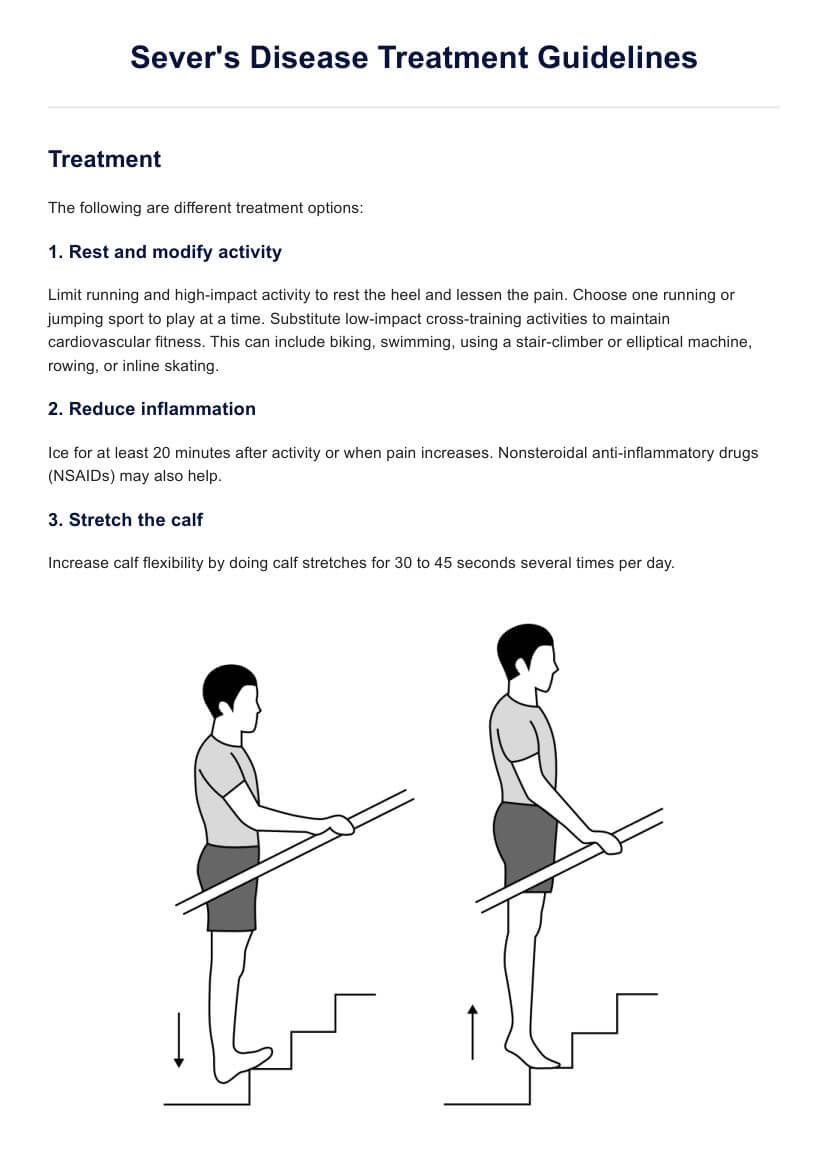Sever's Disease Treatment Guidelines
Learn about Sever's disease treatment guidelines with Carepatron's free PDF download. Get insights on effective treatment for this children's heel condition.


What is Sever's disease?
Sever's disease, also known as calcaneal apophysitis, is a common cause of heel pain in growing children and adolescents. It specifically affects the growth plate, a vulnerable area located at the back of the heel bone where the Achilles tendon attaches. This condition occurs due to repetitive stress and overuse, often seen in active youngsters involved in sports or activities that involve running and jumping.
The primary characteristic of developing Sever's disease is intense heel pain, typically felt during or after physical activities. This discomfort stems from inflammation and irritation at the growth plate caused by the pull of the Achilles tendon and tight calf muscles. It's crucial for parents and a child's doctor to recognize the symptoms of Sever's disease during the growth spurt stage. This can be when active children complains of severe pain in leg muscles or one or both heels, or doing running and jumping activities to play sports.
Symptoms of Sever's disease
Sever's disease manifests through several key symptoms, primarily affecting children and adolescents during periods of rapid growth. Recognizing these signs can aid in early intervention and management:
- Heel pain: Persistent pain in the back or bottom of the heel, especially after physical activity.
- Limping or walking on toes: Children may favor walking on their toes to alleviate heel discomfort.
- Swelling and tenderness: The affected heel may appear swollen and feel tender to the touch.
- Difficulty with physical activities: Pain can worsen during or after running, jumping, or other athletic activities.
- Stiffness or tightness in the heel: Limited range of motion due to tight calf muscles or Achilles tendon
Causes of Sever's disease
Sever's disease is primarily caused by repetitive stress and overuse of the heel bone and its growth plate during periods of rapid growth. It commonly affects children and adolescents involved in activities that put stress on the heel, such as running, jumping, or sports like soccer and basketball.
The condition arises due to the pull of the Achilles tendon on the growth plate at the back of the heel bone. Tight calf muscles and a naturally tight Achilles tendon can exacerbate symptoms.
While it's challenging to prevent Sever's disease entirely, managing symptoms early and ensuring proper footwear and stretching exercises can help alleviate discomfort and promote recovery.
Sever's Disease Treatment Guidelines Template
Sever's Disease Treatment Guidelines Sample
How do healthcare professionals diagnose Sever's disease?
Diagnosing Sever's disease involves a combination of clinical assessment and exclusion of other potential causes of heel pain in children and adolescents. Healthcare professionals typically follow a systematic approach to arrive at an accurate Sever's disease diagnosed.
Clinical examination
During the initial consultation, the healthcare provider will conduct a thorough examination of the child's foot and ankle. This includes assessing for symptoms such as heel pain, tenderness, swelling, and any noticeable changes in gait or movement patterns. The provider will also inquire about the child's symptoms, activities, and any recent growth spurts.
Medical history
Obtaining a detailed medical history is crucial in understanding the onset and progression of symptoms. The healthcare provider may ask about the frequency and intensity of the child's heel pain, activities that exacerbate or alleviate symptoms, and any previous treatments or interventions.
Differential diagnosis
To rule out other potential causes of heel pain, such as fractures, tendonitis, or bursitis, the healthcare provider may perform specific tests or imaging studies. X-rays are typically not necessary for diagnosing Sever's disease but may be used to confirm the condition and exclude other possible injuries or abnormalities.
Physical examination
A focused physical examination will assess the flexibility and range of motion of the ankle and foot. Tightness in the calf muscle or Achilles tendon and signs of inflammation around the growth plate are indicators that support the diagnosis of Sever's disease.
Diagnostic criteria
Based on the clinical findings and exclusion of other conditions, the healthcare provider will diagnose Sever's disease if the symptoms and physical examination align with typical presentations. Treatment recommendations will then be tailored to manage symptoms effectively and promote recovery.
Sever's disease treatment
Sever's disease treatment focuses on alleviating pain and discomfort while promoting healing in the growth plate of the heel bone. The approach typically begins with conservative methods and progresses as needed depending on the severity of symptoms and response to treatment.
Rest and activity modification
The initial step in treating Sever's disease involves reducing or modifying activities that exacerbate symptoms. Rest allows the inflamed growth plate to heal and prevents further irritation. Activities such as running and jumping should be minimized until symptoms improve.
Stretching and strengthening exercises
Stretching exercises targeting the calf muscles and Achilles tendon can help relieve tension and improve flexibility. Strengthening exercises for the foot and ankle muscles can provide additional support to the heel and reduce strain on the growth plate.
Supportive shoe inserts
Wearing supportive shoe inserts or orthotics can help cushion the heel and provide additional support during activities. These inserts can help distribute pressure more evenly and reduce stress on the growth plate.
Ice therapy
Applying ice to the affected heel can help reduce inflammation and relieve pain. Ice packs should be applied for about 15-20 minutes at a time, several times a day, especially after physical activity or at the onset of pain.
Pain medication
In cases where pain is persistent or severe, over-the-counter pain relievers such as ibuprofen or acetaminophen may be recommended. These medications can help manage pain and reduce inflammation, but should be used under the guidance of a healthcare provider.
How to use our Sever's Disease Treatment Guidelines template
Our Sever's Disease Treatment Guidelines template provides a structured approach to managing and treating Sever's disease effectively. By following these steps, healthcare providers and caregivers can ensure comprehensive care tailored to the needs of children and adolescents experiencing pain in the heel due to this condition.
Step 1: Initial assessment
Begin by conducting a thorough assessment of the child's symptoms and medical history. This includes identifying factors such as recent growth spurts, activities that exacerbate symptoms, and any previous treatments or interventions.
Step 2: Diagnosis confirmation
Confirm the diagnosis of Sever's disease based on clinical examination findings and exclusion of other potential causes of heel pain. Ensure that symptoms align with typical presentations of growth plate inflammation.
Step 3: Treatment plan development
Utilize the template to develop a personalized treatment plan. This plan should prioritize conservative measures such as rest, activity modification, and the use of supportive footwear or shoe inserts to relieve pressure on the growth plate.
Step 4: Implementation of treatment strategies
Implement the treatment strategies outlined in the template systematically. This may include recommending stretching exercises to improve flexibility, advising on ice therapy for pain relief, and educating parents and caregivers on the importance of adhering to activity modifications.
Step 5: Monitoring and adjustments
Regularly monitor the child's progress and adjust the treatment plan as needed based on their response and symptoms. Reassess periodically to ensure that the treatment is effective in managing pain and promoting healing as the growth plates continue to mature.
Commonly asked questions
Sever's disease typically resolves within a few weeks to several months with appropriate treatment and activity modification.
Ice is generally more effective for relieving pain and reducing inflammation in Sever's disease due to its ability to numb the area and decrease swelling.
Sever's disease (also called calcaneal apophysitis) is not usually present among adults as the underlying cause—an immature growth plate in the heel—is no longer present once skeletal maturity is reached.
Sever's disease can last from a few weeks to several months, depending on the severity of symptoms and adherence to treatment protocols.







































































































